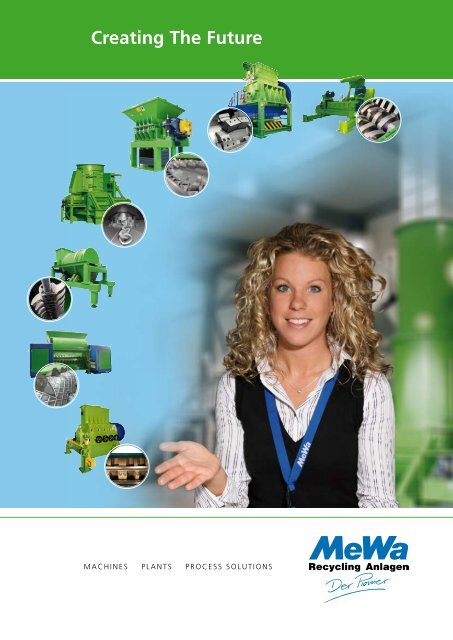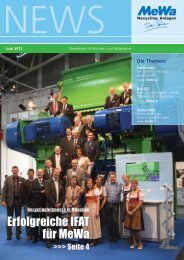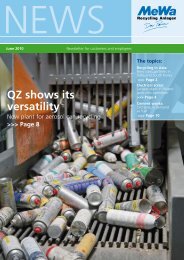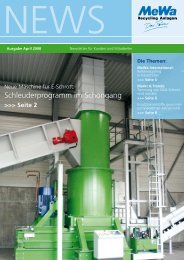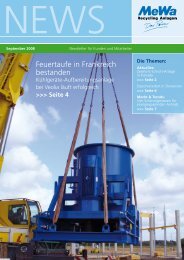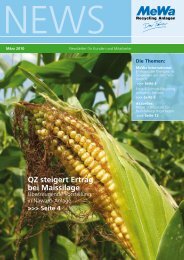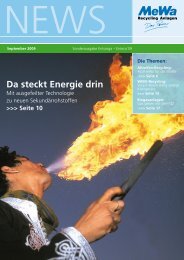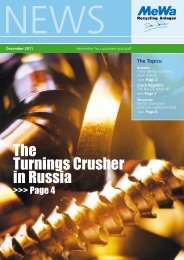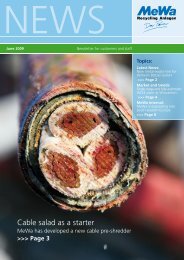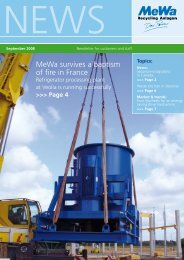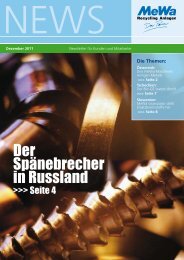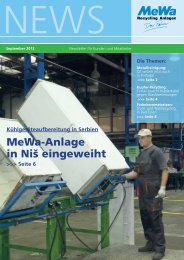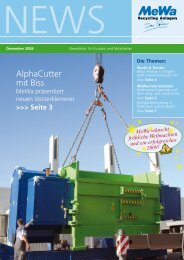Creating The Future - MeWa Recycling Maschinen und Anlagenbau ...
Creating The Future - MeWa Recycling Maschinen und Anlagenbau ...
Creating The Future - MeWa Recycling Maschinen und Anlagenbau ...
Create successful ePaper yourself
Turn your PDF publications into a flip-book with our unique Google optimized e-Paper software.
<strong>Creating</strong> <strong>The</strong> <strong>Future</strong><br />
Machines Plants Process solutions
UNI-CUT®UC rotary shears<br />
endlessly versatile in pre-granulation<br />
>>> Page 6<br />
High-performance<br />
UNI-CUT®UG granulators<br />
For individual grain sizes from 8 to 100 mm<br />
>>> Page 6<br />
UNI-CUT®CC<br />
CableCutter<br />
the specialist for all cable waste<br />
>>> Page 8<br />
UNI-CUT®USM<br />
cutting mills<br />
the perfect cut<br />
for small grain sizes<br />
>>> Page 8<br />
Machine technology<br />
UNI-CUT®AC<br />
AlphaCutter<br />
single-shaft pre-shredder<br />
for difficult materials<br />
>>> Page 10<br />
the diversity of the <strong>MeWa</strong> range of<br />
machines is aligned to the requirements<br />
for the size reduction of different<br />
types of waste. as a single<br />
machine or integrated in complete<br />
plant solutions, recycling machines<br />
from <strong>MeWa</strong> have already proven<br />
their worth more than 1000 times.<br />
Hammer mills<br />
UNI-CUT®UHM<br />
effective purification<br />
>>> Page 17<br />
UNI-CUT®SB<br />
<strong>The</strong> patented<br />
UNI-CUT®QZ<br />
Querstromzerspaner<br />
Perfect in separation.<br />
Perfect in the result.<br />
>>> Page 12<br />
2<br />
Smash Boom Bang<br />
Gentle and effective<br />
>>> Page 12<br />
UNI-CUT®SP<br />
tyre wire cleaner<br />
clean steel wire from<br />
tyre recycling<br />
>>> Page 17<br />
2 3
<strong>Recycling</strong> plants for used tyres<br />
From old tyres to acti<strong>MeWa</strong><br />
>>> Page 6<br />
Cable recycling plants<br />
high-quality fractions in primary<br />
raw material quality<br />
>>> Page 8<br />
Processing of domestic<br />
and industrial waste<br />
solid recovered fuels with<br />
high energy content<br />
>>> Page 10<br />
Plant engineering<br />
Refrigeration<br />
recycling plants<br />
highest recycled resource rates –<br />
complete cFc separation<br />
>>> Page 14<br />
over 300 large-scale plants worldwide<br />
speak for themselves: with size<br />
reduction machinery from in-house<br />
development as well as the specific<br />
separation, sorting and conveying<br />
technology, <strong>MeWa</strong> delivers turnkey<br />
recycling solutions at one stop. Modular<br />
construction means that the<br />
systems can be put together quickly<br />
and efficiently to meet individual requirements.<br />
Processing plants<br />
for electrical<br />
and electronic scrap<br />
single-stage and fully automatic<br />
>>> Page 14<br />
Increased gas output<br />
by up to 30 %<br />
life‘s a gas with the QZ<br />
>>> Page 18<br />
Metal-cleaning plants<br />
effective separation<br />
>>> Page 16<br />
4 5
Tyre recycling<br />
From old tyres to fine rubber powder<br />
Three-stage process delivers high-quality secondary raw material<br />
With the active fine milling process for used tyres, <strong>MeWa</strong><br />
produces a substitute raw material of a single material type.<br />
<strong>The</strong> fine granulate (Acti<strong>MeWa</strong>) can be mixed with other<br />
materials without difficulty to manufacture rubber products.<br />
In road construction, there is a great demand for Acti<strong>MeWa</strong><br />
as an additive to bitumen.<br />
Granulation line.<br />
Acti<strong>MeWa</strong><br />
Recycle before incineration – this<br />
guiding principle also applies to<br />
used tyres from passenger cars<br />
and trucks. in hungary and Kazakhstan,<br />
<strong>MeWa</strong> recently built two highly modern<br />
processing plants for old tyres, producing<br />
acti<strong>MeWa</strong> for direct deployment in road<br />
construction.<br />
in the three-stage processing principle<br />
(pre-granulation, granulation, fine milling),<br />
rotary shears first of all fragment<br />
the complete used tyres into shreds the<br />
size of the palm of your hand.<br />
the precisely machined cutters of the uc<br />
are seated on a polygon-shaped rotor. this<br />
enables the machine to achieve optimised<br />
power transmission. even with metallic<br />
parts, the uc shows its irresistible bite.<br />
subsequently, a granulation line processes<br />
the pieces of tyre step by step into a rubber<br />
granulate of a single material type.<br />
in a complex process, various separation<br />
processes separate the steel and textile<br />
fibres from the pieces of rubber. the<br />
size of the granules is between 0 and 4<br />
millimetres with a final purity of 99.95<br />
percentage by weight.<br />
Active fine milling<br />
<strong>MeWa</strong> integrated the newly developed<br />
fine milling process as a third process stage<br />
for the first time in both plants in hungary<br />
and Kazakhstan. Powdery acti<strong>MeWa</strong><br />
of the highest purity is the result at the<br />
end of the process. it can be added directly<br />
to the new rubber to manufacture<br />
rubber products.<br />
Deployment in road construction<br />
acti<strong>MeWa</strong> is also used in road construction<br />
as an additive to bitumen. the rubber<br />
granulate not only balances out temperature<br />
differences to a considerably better<br />
degree, thus preventing the formation of<br />
cracks, but the mixture also dampens the<br />
noise level of the road surface and provides<br />
significantly greater adhesion for vehicles<br />
in the rain.■<br />
Universal rotary shear UC 150.<br />
Rotor shears and granulator<br />
Active fine milling.<br />
A double plus<br />
With their reliability, the versatile<br />
granulators and rotary shears have advanced<br />
to become the truly successful<br />
team of machines in the <strong>MeWa</strong> machine<br />
pool. together, the two machines fragment<br />
above all tyres, cables, oil filters<br />
and mixed wastes into homogeneous<br />
fractions in all desired grain sizes.<br />
Perfectly geared to one another<br />
the duo is deployed at several<br />
h<strong>und</strong>red locations in pre-granulation and<br />
finish-crushing. here, operation times<br />
of more than 70,000 hours of operation<br />
are no rarity. as far as throughput<br />
is concerned, the team of machines is<br />
perfectly co-ordinated.<br />
the rugged machines have been<br />
conceived for metal processing, which<br />
means they display exceptional stamina<br />
even in highly demanding applications.<br />
UG cutting mechanism.<br />
6 7
CableCutter<br />
Cable processing CableCutter and USM<br />
<strong>The</strong> modern copper mine<br />
Turnkey cable processing plants from <strong>MeWa</strong><br />
have been delivering the highest output<br />
qualities for years. A processing plant in Budapest<br />
has now integrated the newly developed<br />
UNI-CUT ® CC CableCutter into its plant.<br />
Initial conclusion:<br />
grade 1 in economic efficiency.<br />
Electrical scrap, telecommunications,<br />
old cars, mining, high-voltage cables<br />
- today, approximately 150,000 metric<br />
tonnes of cable waste is produced per<br />
year in Germany alone. <strong>und</strong>ergro<strong>und</strong>, millions<br />
more kilometres have been laid, and<br />
these have to be replaced at some time or<br />
other. With the copper, aluminium, lead<br />
and steel metals they contain, the lines are<br />
extremely rich in recyclable resources.<br />
in hungary‘s capital Budapest, a company<br />
has specialised in recycling cables.<br />
not far from the banks of the Danube,<br />
the facility has installed a processing line<br />
with pre-granulation, granulation and fine<br />
granulation.<br />
Partner for precision work<br />
if aluminium, copper cables, plastics<br />
or tyres are to be granulated, the unicut<br />
® usM cutting mill handles the precision<br />
work. the rugged <strong>MeWa</strong> cutting<br />
mill is in demand everywhere small grain<br />
sizes are required.<br />
in cable processing, the cutting mills<br />
cut the enclosed metal from its cladding.<br />
co-ordinated cutting and separation<br />
units then extract metal fractions<br />
of a single material type, for example<br />
copper. Plastics and rubber from the insulation<br />
material are left behind.<br />
in the modern tyre processing plants,<br />
the machine is often set up in a row of<br />
four located upstream of the cutting<br />
and separating units. in a number of<br />
runs, the rubber granulate is cleaned<br />
and finally fragmentised by the 5.5 metric<br />
tonne machine to a size of less than<br />
4 millimetres in diameter.<br />
CableCutter CC 1200.<br />
Specialist for cable fragmentisation<br />
the company has now invested in an<br />
additional special machine that can further<br />
increase the efficiency of processing.<br />
the cutting geometry of the new cc 1200<br />
cablecutter from <strong>MeWa</strong> has been specially<br />
geared to taking cables apart.<br />
With a throughput of up to three metric<br />
tonnes per hour, this technical innovation<br />
is highly effective. the easy-to-change<br />
granulating screen achieves grain sizes of<br />
10 to 50 millimetres in diameter. special<br />
sizes are available as required. the input<br />
shaft is 2.30 metres wide, i.e. configured<br />
for loading by means of power shovels.<br />
Copper sorted by material type<br />
the initial processing with the new unit<br />
is so precise that even one subsequent granulation<br />
stage is sufficient to be able to<br />
feed the material directly to the final cutting<br />
mills. the result: copper in primary<br />
raw material quality. ■<br />
Cutting mill USM 1000.<br />
8 9
Solid recovered fuels AlphaCutter<br />
Turnkey <strong>MeWa</strong> plant in Ghent with<br />
vibrating screen, wind screening,<br />
metal separator and granulation line.<br />
Pre-granulation takes place outside<br />
of the shop.<br />
Flywheel mass drive<br />
For more than 20 years now,<br />
<strong>MeWa</strong> granulators have been driven<br />
by flywheels weighing 3 to 5 metric<br />
tonnes. the flywheel serves simultaneously<br />
as a belt pulley for a simple<br />
V-belt drive that works with the<br />
lowest possible losses due to friction.<br />
the energy of the disk flywheel covers<br />
the peak torques required in the<br />
short term. this means that the electrical<br />
drive motor runs smoothly, significantly<br />
below the rated voltage<br />
range. expensive peak loads do not<br />
occur in the first place.<br />
Maintenance-free coupling system<br />
a sophisticated coupling and<br />
control system monitors the speed,<br />
torque and current consumption of the<br />
machine. this prevents high start-up<br />
peaks of the electrical drive motor<br />
and in the event of sudden blocking<br />
the flywheel is uncoupled so that the<br />
machine is not damaged.<br />
Manufacture of Solid Recovered Fuels<br />
<strong>MeWa</strong> has developed the high-performance<br />
AlphaCutter for large throughput volumes and<br />
materials that are difficult to process such as<br />
mattresses, truck tarpaulins, large compressed bales<br />
or rolls of foil. <strong>The</strong> unit is handling the pre-granulation<br />
in plants for the manufacture of solid recovered fuels.<br />
the new alphacutter series from<br />
<strong>MeWa</strong> is equipped with four disk<br />
flywheels. two of these on each side<br />
gear down the speed of the drive<br />
motors from 1500 revolutions to<br />
approx. 70 revolutions. <strong>MeWa</strong> CEO Ulrich Hink in front of two of the four<br />
disk flywheels of the AlphaCutter XXL 3700.<br />
<strong>The</strong> first encounter leaves a lasting impression:<br />
the alphacutter is hungry.<br />
the new bulky waste shredder<br />
devours enormous quantities of household,<br />
commercial and industrial waste.<br />
the homogeneous fragmentation means<br />
that the throughput can also be increased<br />
in the downstream granulation<br />
line by more than 30%. Particularly in the<br />
Der Schwungmassenantrieb<br />
im AlphaCutter XXL 3700.<br />
case of materials that are difficult to process<br />
such as mattresses, truck tarpaulins<br />
or large compressed bales, the progress<br />
made compared to other machine solutions<br />
is enormous.<br />
AlphaCutter XXL for<br />
high throughput<br />
the alphacutter XXl 3700 is particularly<br />
suitable for facilities that have to<br />
handle very large volumes of waste. up<br />
to 60 metric tonnes of mixed wastes per<br />
hour can be processed with the high-performance<br />
unit.<br />
Depending on requirements, version l<br />
with a rotor length of 2200 millimetres and<br />
version Xl with a rotor length of 3200 millimetres<br />
supplement the range of available<br />
products.<br />
Turnkey plants<br />
<strong>MeWa</strong> builds and delivers turnkey<br />
plants for the processing of household<br />
and industrial waste, providing services<br />
from the first draft design to commissioning<br />
at one stop. Depending on the requirements<br />
of the customer, <strong>MeWa</strong> creates<br />
pure sorting plants with manual sorting or<br />
mechanical separation all the way to complex<br />
plant concepts with sophisticated cutting/separating<br />
techniques for the manufacture<br />
of solid recovered fuels.<br />
near Ghent, for example, the<br />
British shanks Group operates<br />
a complete <strong>MeWa</strong> plant for the<br />
processing of mixed construction waste.<br />
Three granulators<br />
Following pre-granulation, vibrating<br />
screens, wind screening, metal separators,<br />
near-infrared technique as<br />
well as three large granulators ensure<br />
output sorted by material type and a<br />
throughput of 35 metric tonnes per hour<br />
the main purchaser of the high-calori-<br />
fic substitute fuels is the cement industry<br />
in Belgium. ■<br />
10 11
Querstromzerspaner<br />
<strong>The</strong> patented UNI-CUT ® QZ Querstromzerspaner has<br />
replaced the traditional fragmentation technology with<br />
chain tools – and thus thoroughly revolutionised the<br />
process with a level of success that literally makes a bang.<br />
<strong>The</strong> new Smash Boom Bang is the junior partner in electrical<br />
scrap recycling.<br />
Smash Boom Bang<br />
Where the hurricane rages inside<br />
<strong>The</strong> Querstromzerspaner and Smash Boom Bang revolutionise<br />
recycling technology<br />
Electrical and electronic scrap, refrigeration<br />
devices, aluminium composites, plastic-metal<br />
composites of all types, but also biological<br />
waste - the Querstromzerspaner is deployed<br />
everywhere different material mixtures have to be<br />
broken down. the patented QZ was developed to<br />
separate a wide variety of composite materials.<br />
in the meantime, the technology that works<br />
according to a completely new concept has developed<br />
into the most successful machine in the<br />
<strong>MeWa</strong> range of products. in contrast to cutting<br />
tools, the Querstromzerspaner separates the material<br />
with its acceleration instruments. here, the<br />
chains generate a kind of cyclone in the processing<br />
chamber.<br />
the QZ exploits the physical forces of the impact<br />
energy, thus guaranteeing particularly fast<br />
and gentle material separation. even after a few<br />
seconds, secondary metals of high purity that are<br />
fit for the market exit from the drum of the machine.<br />
Low wear costs<br />
compared to cutting processes or swing-hammer<br />
pulverisers, the resulting<br />
wear costs are significantly lower. in the<br />
meantime, the patented Querstromzerspaner<br />
is deployed worldwide in<br />
a wide variety of plant variants.<br />
refrigeration devices<br />
and electrical scrap in particular<br />
can be gently and<br />
economically fragmented<br />
with <strong>MeWa</strong> technology.<br />
With different drum<br />
sizes from 900 to 2500<br />
millimetres, the suitable machine for every requirement<br />
is on hand.<br />
Smash Boom Bang – the solution for small<br />
electrical appliances<br />
in the field of pre-granulation of electrical and<br />
electronic scrap, <strong>MeWa</strong> has conceived a supplementary<br />
solution: the smash Boom Bang. this<br />
technical innovation is particularly suitable for<br />
small electrical appliances. after processing, the<br />
housing, processor boards, motors, cables, transformers<br />
lie exposed; parts containing pollutants,<br />
for example capacitors and batteries, remain<br />
intact. the individual components can be<br />
easily taken from the conveyor belt by hand in<br />
the next operation.<br />
the dismantling machine saves the time-consuming<br />
and costly manual pre-dismantling of the<br />
electrical appliances while still enabling the plants<br />
to carry out combined processing of the wastes in<br />
one mechanical and manual system. ■<br />
Smash Boom Bang.<br />
12 13
Fridge recycling<br />
Single-stage, fully automatic and environmentally friendly<br />
WEEE processing plants for electrical scrap and refrigerators convince with their economic efficiency and the highest environmental standards<br />
In line with the WEEE Directive of the European Union, many<br />
nations have established an effective recycling system for<br />
electrical and refrigeration devices. Very often, the Querstromzerspaner<br />
(QZ) from <strong>MeWa</strong> plays the main role in this process.<br />
<strong>The</strong> machine takes the appliances apart in a single-stage process<br />
in a particularly efficient and gentle manner.<br />
E<br />
lectrical appliances and refrigeration<br />
devices constitute the flow<br />
of waste with the highest growth<br />
in europe. alongside numerous recyclable<br />
resources, however, the devices and<br />
appliances also contain harmful substances.<br />
across europe, more than 200 million<br />
cFc refrigeration devices are still<br />
operated. these generations of devices<br />
are now coming in for recycling. the environmentally<br />
harmful chlorofluorocarbons<br />
are in the refrigerant and in the<br />
appliance insulation.<br />
in austria, a country that requires<br />
particularly high environmental stan-<br />
dards in this area, <strong>MeWa</strong> commissioned<br />
a highly modern refrigeration device recycling<br />
plant recently. the new operators<br />
and attending guests from the field<br />
of politics agreed at the opening: „With<br />
<strong>MeWa</strong> technology, we are setting new<br />
standards in the disposal of refrigeration<br />
devices in europe.“<br />
<strong>The</strong> plant achives 900,000 metric<br />
tonnes of CO 2 reduction<br />
up to 300,000 refrigeration devices<br />
per year will be processed here in future,<br />
recovering aro<strong>und</strong> 90 metric tonnes<br />
of cFcs. the functioning principle of<br />
the plant corresponds to an annual reduction<br />
in the environmental burden of<br />
900,000 metric tonnes of co 2 . For this<br />
Environmental Award for the <strong>MeWa</strong><br />
fridge recycling plant: Daphne in gold.<br />
Fully automatic WEEE-plant in Daventry.<br />
Refrigeration device pro-<br />
cessing plants from <strong>MeWa</strong><br />
convince with high rates<br />
of recycled resource recovery<br />
and complete CFC separation. achievement, the plant in Kematen received<br />
the austrian environmental award<br />
„Daphne“ in gold in March 2009.<br />
With the Querstromzerspaner technology,<br />
cFc and pentane appliances<br />
can be processed simultaneously without<br />
their having to be sorted beforehand.<br />
not only the recovery rate of the<br />
cFc is exceptionally high, but also the<br />
economical operation of the plant and<br />
the high recycled resource rate with ferric,<br />
aluminium / copper and plastic fractions<br />
sorted by material type at the end<br />
of the process have led to the plant type<br />
being deployed in almost all european<br />
countries.<br />
<strong>MeWa</strong> plants for processing<br />
household appliances, home electro-<br />
nics or computers are even more widespread.<br />
With the first plants in canada<br />
and california, the step across the<br />
atlantic has been made.<br />
the patented Querstromzerspaner<br />
also handles the dismantling work for<br />
electrical scrap processing. the parts<br />
containing pollutants, for example capacitors<br />
or batteries, remain intact in the<br />
chain fragmentation process and can<br />
then be sorted without difficulty using<br />
separating techniques or by hand. at<br />
the end of the process, more than 90%<br />
of the input volume is available, cleanly<br />
separated and sorted according to different<br />
material fractions.<br />
Fully automatic operation<br />
in Daventry, england, a highly mo-<br />
Ferric fraction, separated into<br />
a single material type.<br />
Fridge recycling<br />
dern <strong>MeWa</strong> plant configured for fully<br />
automatic sorting was recently commissioned.<br />
after processing in the Querstromzerspaner,<br />
metal detectors, ferric<br />
and non-ferric separators, plastic sorting<br />
devices, circuit board separators, proximity<br />
infrared devices as well as air separators<br />
separate the material into different<br />
material flows. only four to six<br />
employees per shift are responsible for<br />
ongoing operation.<br />
the combination of refrigeration device<br />
and electrical scrap processing can<br />
also be implemented using QZ technology.<br />
in st. helens, england, <strong>MeWa</strong> put<br />
europe‘s biggest processing plant into<br />
operation for mixed treatement with devices<br />
classified according to the european<br />
Weee Directive. ■<br />
14 15
Metal composites<br />
Resistance is pointless<br />
QZ separates metal composites ready for<br />
the steel mill<br />
When breaking down metal-plastic mixtures, the Querstromzerspaner<br />
delivers particularly good results. One of the tasks is to<br />
clean metals that have already run through magnetic separators<br />
in sorting systems for domestic and industrial waste.<br />
Companies that specialise in processing<br />
special scrap have moved into<br />
industrial centres with very good<br />
transport links.<br />
at first glance, the volume of waste collected<br />
there in the yard and in the shop<br />
High quality fractions in<br />
primary raw material qualities.<br />
looks like normal domestic and industrial<br />
waste.<br />
Processing for use in steel works<br />
however, the composition differs<br />
f<strong>und</strong>amentally. the waste consists of<br />
more than 60 % metal. the plants have<br />
specialised in processing the so-called<br />
metal separation fraction<br />
from sorting or metal processing<br />
plants so that it can<br />
be used in steel works. the<br />
delivered metal fractions,<br />
for example tinplate cans,<br />
still adhere to a great extent<br />
to external materials.<br />
the <strong>MeWa</strong> Quer-<br />
stromzerspaner has proven<br />
to be the ideal technology<br />
to separate these<br />
stubborn composites. the<br />
positive results have<br />
led a number of companies<br />
to invest in this<br />
direction in the past few<br />
months. existing plants<br />
Input motor blocks: the QZ separates<br />
brass-aluminium composites.<br />
have also extended their processing to include<br />
other lines with the patented Querstromzerspaner.<br />
Low wear costs<br />
together with the separating techniques<br />
that are geared to it, the chain<br />
principle of the <strong>MeWa</strong> QZ ensures high<br />
throughputs, output fractions sorted by<br />
material type and low wear costs. Particularly<br />
in the last point, the advantages<br />
compared to cutting shredder systems are<br />
huge.<br />
Metal composites of all types<br />
as a general principle, the QZ process<br />
is suitable for the separation of a wide variety<br />
of metal composites. applications involving<br />
components made of aluminium<br />
are just as frequent as the processing of<br />
swarf and metal chips. after all, the result<br />
is plastic, non-ferric and ferric fractions –<br />
ready for collection by the steel works and<br />
resmelting shops that are connected by<br />
the relevant transport systems. ■<br />
Tyre wire cleaner separates<br />
steel and rubber<br />
Tyres contain a substantial amount of steel wire. For this<br />
content, <strong>MeWa</strong> has developed the UNI-CUT ® SP tyre wire<br />
cleaner. This special machine removes textile and rubber<br />
residues from the steel wires, fully recovering the metal<br />
in the highest quality.<br />
16 17<br />
I<br />
n order to protect the machines in the<br />
downstream tyre recycling process<br />
steps against excessive<br />
the wire is removed<br />
from the process<br />
directly after the<br />
first granulation step<br />
by magnetic separators.<br />
this fraction, however, is in a very unclean<br />
state at this point. along with the<br />
wires, aro<strong>und</strong> 10 to 35 percentage by<br />
weight of rubber and textiles is also withdrawn.<br />
this proportion is too high for use<br />
in a steel smelter. <strong>MeWa</strong> has now specifically<br />
devoted its attention to this fraction.<br />
equipped without sensitive blades,<br />
the tools mounted on the rotor shaft rub<br />
Tough refinement<br />
<strong>The</strong> double swing-hammer mill<br />
uses a kinetic impact effect to<br />
pulverise the material to be<br />
gro<strong>und</strong>. two rotors, to which steel<br />
hammers are attached, rotate in a metal<br />
housing. the impact of the hammers<br />
pulverises the conveyed materials.<br />
the hammers sling the units<br />
against the grinding wall, where the<br />
impact breaks them up further. the<br />
gro<strong>und</strong> material remains in the pulverisation<br />
zone until it is small enough<br />
to pass through a defined screen. this<br />
screen determines the output size of<br />
the material. a characteristic of the<br />
hammer mill is also the spherical output.<br />
■<br />
the rubber and steel mixture on the stator<br />
shaft of the machine against one another,<br />
thus exposing the<br />
individual fractions.<br />
specially configured<br />
vibration<br />
channels and magnets<br />
separate the<br />
exposed wire, textile<br />
and rubber fractions. the entire separation<br />
plant is encapsulated. this enables<br />
exposed textiles to be blown out via air<br />
separation devices and captured in a filter.<br />
the turnkey <strong>MeWa</strong> line is also equipped<br />
with its own control system. at the<br />
end, the wire emerges with a purity of greater<br />
than 98% – ready to use in a steel<br />
smelter. ■<br />
<strong>The</strong> UNI-CUT ® UHM Hammer mill has proven effective<br />
in the preparation of material mixtures of plastic, aluminium<br />
and copper. <strong>The</strong> advantage: fractions sorted by<br />
material type can be extracted in defined grain sizes.<br />
This is frequently a requirement for the manufacture of<br />
new products from recycling material.<br />
Output: Copper<br />
and aluminium.<br />
Tyre wire cleaner and<br />
Hammer mill
Bio QZ Bio QZ<br />
Extract the maximum<br />
Biogas plants: Querstromzerspaner from <strong>MeWa</strong><br />
prepare substrates ideally for the bacteria<br />
Increasing the gas yield, stabilising the operating state,<br />
reducing the holding time in the fermenter – in short:<br />
many plant operators will soon be optimising<br />
existing biogas plants. With the Querstromzerspaner<br />
(QZ), <strong>MeWa</strong> offers a solution that starts right at<br />
the front of the process chain. „Properly preparing<br />
substrates“ is the simple but effective formula for the<br />
patented machine.<br />
Whether fuel crops from the<br />
fields, expired foodstuffs, biological<br />
waste from bins,<br />
slaughterhouse waste or surplus seasonal<br />
crops – there is a great deal of energy<br />
in the biomass. converting this energy<br />
quickly and efficiently into usable biogas<br />
is the task of modern fermentation plants.<br />
this is how aro<strong>und</strong> 5,000 biogas plants in<br />
Germany produce environmentally friend-<br />
ly power and heat, and the trend is on the<br />
up and up.<br />
however, an important process step<br />
has often been neglected during planning.<br />
exploitation of the substrates in fermentation<br />
can only be optimised with the right<br />
separation. this means that the strains of<br />
bacteria in the fermenter can only begin<br />
their decomposition process quickly and<br />
Querstromzerspaner<br />
QZ 900.<br />
effectively when the cell structure of the<br />
input materials has been broken up.<br />
With the patented Querstromzerspaner<br />
(QZ), <strong>MeWa</strong> offers the suitable solution<br />
for this application. instead of cutting<br />
up the input materials, the Bio-QZ works<br />
with the principle of a pestle and mortar.<br />
this creates a significantly larger contact<br />
surface for the bacteria, enabling a significant<br />
rise in the energetic yield of the<br />
substrates. rotating chains on the floor<br />
of the machine chop up the fuel crops in<br />
seconds. „this gives the substrate a<br />
homogeneous composition, making it<br />
much more ‚palatable‘ for the bacteria,<br />
so to speak,“ says a biogas plant operator<br />
in describing the result.<br />
the principle provides sustained effects<br />
above all in the case of agricultural plants<br />
that feed fuel crops from the field into the<br />
fermenter. Where the Bio-QZ has been<br />
retrofitted, a significantly more stable<br />
operating state of the entire biogas plant<br />
has been achieved. the homogeneously<br />
prepared substrate can not only be<br />
pumped more easily, the energy-intensive<br />
stirring periods in the fermenter can also<br />
be more than halved. Floating layers disappear<br />
very quickly. a farmer in nördlingen,<br />
Bavaria, describes the situation in his plant:<br />
„the material in the fermenter now moves<br />
of its own accord. it‘s visibly alive.“<br />
30 % more gas yield<br />
Depending on the input material used<br />
originally, up to 30 % more gas yield is<br />
measured in plants with Bio-QZ operation.<br />
evaluations have also indicated a higher<br />
methane content in the biogas. and<br />
an even more far-reaching difference can<br />
be determined compared to before: in the<br />
plant in nördlingen, the yard now stock-<br />
piles not only corn silage but now also<br />
seasonal crops such as red beets, potatoes,<br />
oil radish, sugar beets or grass cuttings.<br />
„it is now much more flexible to feed<br />
the plant, enabling me to exploit seasonal<br />
business,“ says the farmer.<br />
Insensitive and versatile<br />
in the meantime, the machine has<br />
proven its suitability for the preparation<br />
of substrates on a wide variety of plant<br />
categories. alongside the renewable resources<br />
plants that operate with a high<br />
dry-substance content, the principle also<br />
delivers the same positive results in municipal<br />
fermentation plants with biological<br />
waste bins as well as for slaughterhouse<br />
waste and packaged foodstuffs, for<br />
example. the machine is also insensitive<br />
to metal parts or stones and completely<br />
unwraps packaging. in a downstream<br />
separator circuit, the packaging can be<br />
easily removed from the biomass. ■<br />
<strong>The</strong> QZ 1600 at work.<br />
18 19<br />
Corn silage.<br />
Fruit and vegetables. Slaughterhouse waste.<br />
Packaged food.<br />
Red beets.<br />
Sugar beets.
001 0810 2000/e<br />
Company<br />
Mewa recycling<br />
<strong>Maschinen</strong> <strong>und</strong> anlagenbau Gmbh<br />
Gültlinger straße 3<br />
75391 Gechingen/Germany<br />
tel. +49 (0)7056 925-0<br />
Fax +49 (0)7056 925-169<br />
info@mewa-recycling.com<br />
www.mewa-recycling.com<br />
<strong>MeWa</strong> recycling <strong>Maschinen</strong> <strong>und</strong> anlagenbau<br />
Gmbh has been playing a leading<br />
role in the recycling industry for more than<br />
25 years. the core business is on deve-<br />
loping and building recycling machines<br />
and engineering turn-key plant solutions.<br />
<strong>MeWa</strong> machinery is processing electric-<br />
and electronic scrap, fridges, tyres,<br />
domestic and industrial waste, oil filters<br />
and organic waste for biogas plants. Being<br />
an international market leader, <strong>MeWa</strong>’s<br />
innovative technology is patent-protected.<br />
at the headquarters in Gechingen/<br />
Germany and in other international sites<br />
more than 150 employees are working<br />
for <strong>MeWa</strong>.


